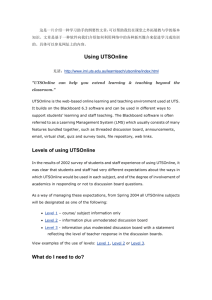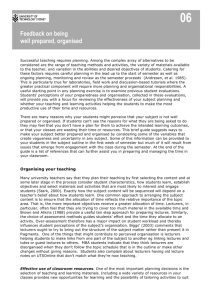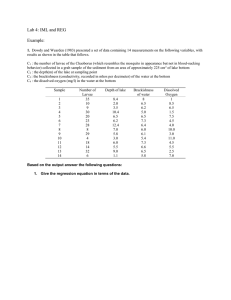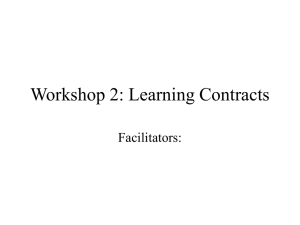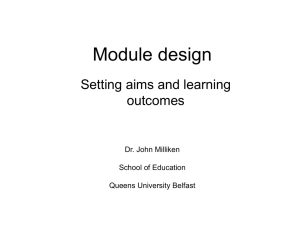Setting Clear aims and objectives
advertisement
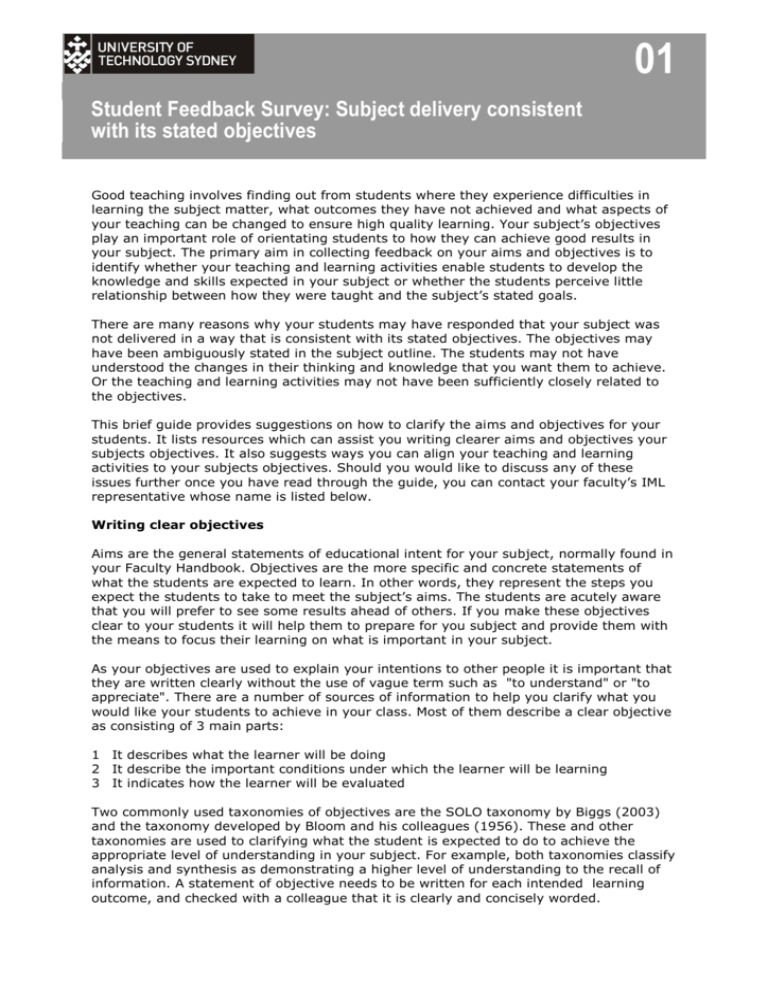
01 Student Feedback Survey: Subject delivery consistent with its stated objectives Good teaching involves finding out from students where they experience difficulties in learning the subject matter, what outcomes they have not achieved and what aspects of your teaching can be changed to ensure high quality learning. Your subject’s objectives play an important role of orientating students to how they can achieve good results in your subject. The primary aim in collecting feedback on your aims and objectives is to identify whether your teaching and learning activities enable students to develop the knowledge and skills expected in your subject or whether the students perceive little relationship between how they were taught and the subject’s stated goals. There are many reasons why your students may have responded that your subject was not delivered in a way that is consistent with its stated objectives. The objectives may have been ambiguously stated in the subject outline. The students may not have understood the changes in their thinking and knowledge that you want them to achieve. Or the teaching and learning activities may not have been sufficiently closely related to the objectives. This brief guide provides suggestions on how to clarify the aims and objectives for your students. It lists resources which can assist you writing clearer aims and objectives your subjects objectives. It also suggests ways you can align your teaching and learning activities to your subjects objectives. Should you would like to discuss any of these issues further once you have read through the guide, you can contact your faculty’s IML representative whose name is listed below. Writing clear objectives Aims are the general statements of educational intent for your subject, normally found in your Faculty Handbook. Objectives are the more specific and concrete statements of what the students are expected to learn. In other words, they represent the steps you expect the students to take to meet the subject’s aims. The students are acutely aware that you will prefer to see some results ahead of others. If you make these objectives clear to your students it will help them to prepare for you subject and provide them with the means to focus their learning on what is important in your subject. As your objectives are used to explain your intentions to other people it is important that they are written clearly without the use of vague term such as "to understand" or "to appreciate". There are a number of sources of information to help you clarify what you would like your students to achieve in your class. Most of them describe a clear objective as consisting of 3 main parts: 1 It describes what the learner will be doing 2 It describe the important conditions under which the learner will be learning 3 It indicates how the learner will be evaluated Two commonly used taxonomies of objectives are the SOLO taxonomy by Biggs (2003) and the taxonomy developed by Bloom and his colleagues (1956). These and other taxonomies are used to clarifying what the student is expected to do to achieve the appropriate level of understanding in your subject. For example, both taxonomies classify analysis and synthesis as demonstrating a higher level of understanding to the recall of information. A statement of objective needs to be written for each intended learning outcome, and checked with a colleague that it is clearly and concisely worded. Developing students understanding of objectives Research conducted by Paul Ramsden (2003) shows that the beginning of any course is a period of uncertainty and confusion. Without a clear understanding of the course goals students are likely to become disorientated and waste time trying to discover what it is you want them to learn. Naturally, you have ensured that your students have access to the subject outline as early in the semester as possible. However, you cannot expect that access to the document means that students will have read your objectives and understood what it is they are expected to learn. It is important that you provide students with an opportunity in your class to know why they are learning these things. Helping students translate the learning objectives into learning outcomes allows them to see exactly what they are, when they are due and what standard of work that is expected. A discussion of the objectives is your opportunity to demonstrate your enthusiasm for the subject and the relevance to the overall course. Alignment of teaching and learning activities with objectives Your teaching and learning activities need to provide students with opportunities to acquire the knowledge and skills they require to demonstrate that they have met the subject’s objectives. It is critical that the students are actively involved and that they are able to gauge their own progress toward meeting the objective. If you suspect your teaching and learning activities are not providing student with the appropriate knowledge and skills, ask your subject coordinator for suggestions on how to strengthen the link between the objectives and what the students do in the classroom. Further Reading > Biggs, J. (19993). Teaching for quality leanring in higher education. Open Uni8versity Press. > Bloom, B. (1956) Taxonomy of Educational Objectives, Handbook 1, Cognitive Domain. New York:Longman. > Mager, R. (1962) Preparing Instructional Objectives, California: Lear Siegler, Inc. > Ramsden, P. (2003), Learning to Teach in Higher Education, London: Routledge It would be appropriate to take your initial response to your student feedback results to your academic supervisor. The IML can also assist in interpreting your student feedback results. If you like to discuss any aspect of your teaching, please contact the IML liaison person within your faculty. Details are on the IML web site: http://www.iml.uts.edu.au/about/contact.html The IML welcomes feedback, suggestions and contributions to this guide on improving student feedback. Please contact Peter.Kandlbinder@uts.edu.au with suggestions for future items of interest.

